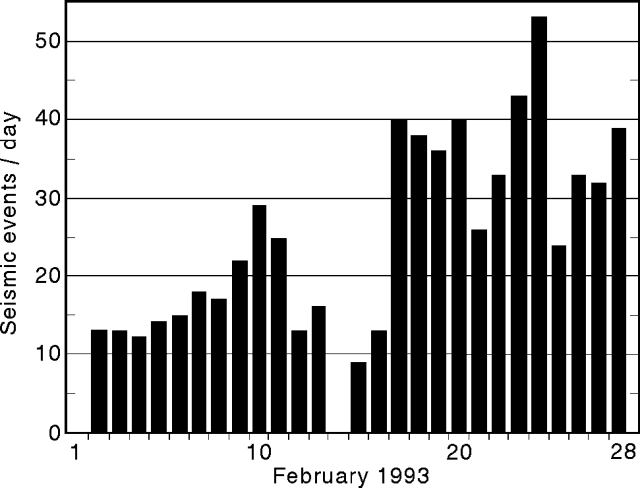Report on Arenal (Costa Rica) — February 1993
Bulletin of the Global Volcanism Network, vol. 18, no. 2 (February 1993)
Managing Editor: Edward Venzke.
Arenal (Costa Rica) Gas emission, explosions, lava flows continue; tremor activity increases
Please cite this report as:
Global Volcanism Program, 1993. Report on Arenal (Costa Rica) (Venzke, E., ed.). Bulletin of the Global Volcanism Network, 18:2. Smithsonian Institution. https://doi.org/10.5479/si.GVP.BGVN199302-345033
Arenal
Costa Rica
10.463°N, 84.703°W; summit elev. 1670 m
All times are local (unless otherwise noted)
Gas emission, explosions, and lava flows continued from Crater C. Strombolian activity was similar to last month, with relatively quiet explosions of moderate size that produced columns, with minor ash content, to 500-1,000 m above Crater C. Ash fell 1.8 km W of the active crater down to 735 m elevation. Sudden small-moderate degassing events, separated by a few to tens of minutes, were accompanied by frequent loud sounds. A pyroclastic flow in mid-February moved down the S flank to 850 m elevation.
The lava flow that began to descend in December 1992 remained active after dividing into two lobes at 1,100 m elevation. The W lobe, with an approximate thickness of 18 m, descended to 800 m elevation in February. During the same period, the SE lobe descended from a flat area just above 800 m down to 700 m elevation.
Tremor activity recorded at Fortuna station, 3.5 km E of the active crater, has increased since the end of January. The increase is thought to be associated with the rise of new magma to the surface. The number of seismic events (average of 36/day; figure 52), was similar to last month and in the normal range. However, there was an increase in the number of seismic events after each tremor episode.
 |
Figure 52. Number of seismic events/day at Arenal (Fortuna station), February 1993. Courtesy of G. Soto and R. Barquero. |
Sulfur and chlorine gas emissions from fumaroles on the rim of Crater C continued to produce acid rain that has damaged vegetation on the NE, E, and SE flanks. Fumarolic activity continued from Crater D.
Geological Summary. Conical Volcán Arenal is the youngest stratovolcano in Costa Rica and one of its most active. The 1670-m-high andesitic volcano towers above the eastern shores of Lake Arenal, which has been enlarged by a hydroelectric project. Arenal lies along a volcanic chain that has migrated to the NW from the late-Pleistocene Los Perdidos lava domes through the Pleistocene-to-Holocene Chato volcano, which contains a 500-m-wide, lake-filled summit crater. The earliest known eruptions of Arenal took place about 7000 years ago, and it was active concurrently with Cerro Chato until the activity of Chato ended about 3500 years ago. Growth of Arenal has been characterized by periodic major explosive eruptions at several-hundred-year intervals and periods of lava effusion that armor the cone. An eruptive period that began with a major explosive eruption in 1968 ended in December 2010; continuous explosive activity accompanied by slow lava effusion and the occasional emission of pyroclastic flows characterized the eruption from vents at the summit and on the upper western flank.
Information Contacts: G. Soto and R. Barquero, ICE; E. Fernández and J. Barquero, OVSICORI.

